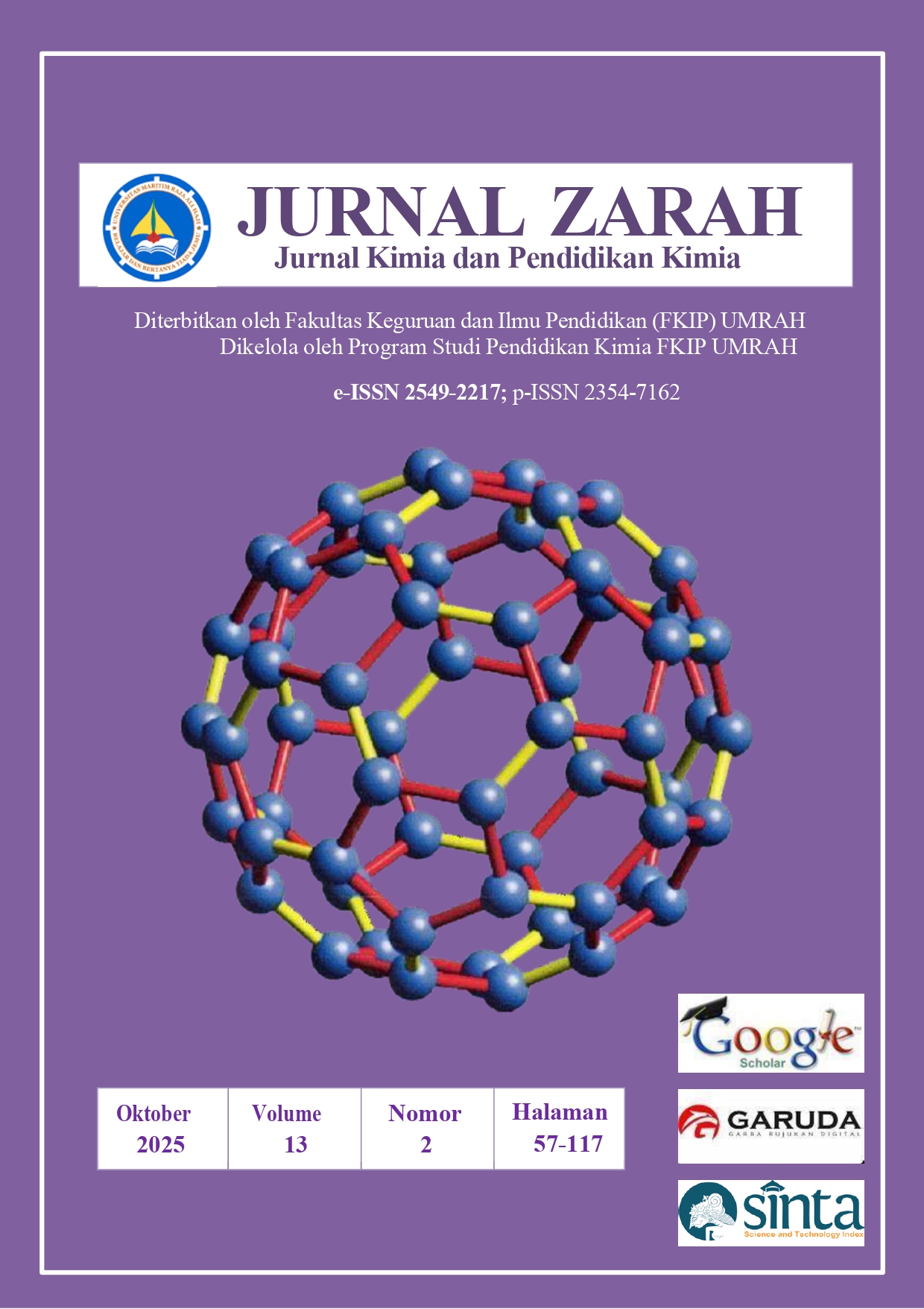CHEMISTRY ONLINE COURSE: ITS IMPLEMENTATION FOR PRESERVICE CHEMISTRY TEACHERS’ PROFILE OF COLLABORATION SKILLS AND COMMUNICATION CONFIDENCE
Keywords:
Online learning , Chemistry learning , Collaboration Skill, Communication ConfidenceAbstract
The development of sience, technology, and transformation in various sector allows the need of capable measure: how effective their role in learning interactions. This study seeks to reveal the profile of collaboration skills (CS) and communication confidence (CC) of pre-service chemsitry teacher (PCT). Convenience sampling technique was adopted for this study. A total of 26 PCTs were involved as research samples. The research intervention was conducted through six online lectures for PCT. Group discussions and presentations were implemented to collect data. Therefore, non-tests were used as data collection techniques. Data were obtained through two closed-ended questionnaires: the Collaborative Skill Questionnaire (CS-Q) and the Communication Confidence Questionnaire (CC-Q). The validity of the instruments was tested theoretically and empirically. Sixteen of the 20 CS-Q items and 22 of the 30 CC-Q items were valid. The Cronbach's alpha reliability estimates for the CS-Q and CC-Q instruments were 0.753 and 0.804, respectively. With data in the form of a Likert scale, descriptive statistics were used to analyze the profile levels of the PCT-CS and PCT-CC. The level criteria were divided into five categories. Based on these results, the PCT-CS was generally at a good level. Meanwhile, the PCT-CC level was sufficient. Based on the research results that have gone through the data analysis stage, learning activities need to implement methods that are capable of training PCT-CS and PCT-CCReferences
Anazifa, R. D., Suratsih., Kuswandi, P. C., Pratama, A. T. (2023). Explrong students’ perspective on using online collaborative paltform in biology laboratory work. Scientiae Educatia, 12(1), 12-24.
Barkley E. F., Major C. H. and Cross K. P. (2014). Collaborative learning techniques: A handbook for college. Jossey-Bas.
Bernie, C. F. (2009). 21st century skills: learning for life in our times. John Willey & Sons.
Blizak, D., Blizak, S., Bouchenak, O., & Yahiaoui, K. (2020). Students’ perceptions regarding the abrupt transition to online learning during the covid-19 pandemic: case of faculty of chemistry and hydrocarbons at the university of boumerdes— algeria. Journal of Chemical Education, 97(9), 2466-2471.
Capdeferro, N., & Romero, M. (2012). Are online learners frustated with collaborative learning experiences? International Review of Research in Open and Distributed Learning, 13(2), 26–44.
Çakiroğlu, Ü., & Aksoy, D. A. (2017). Exploring extraneous cognitive load in an instructional process via the web conferencing system. Behaviour & Information Technology, 36(7), 713-725.
Cheng SH, Sun ZJ, Lee IH, Lee CT, Chen KC, Tsai CH, Yang YK, Yang YC. Factors related to self-reported social anxiety symptoms among incoming university students. Early Interv Psychiatry, 11(4):314–321.
Dewi, A. P., Putri, A., Anfira, D. K. & Prayitno, B. (2020). Profil keterampilan kolaborasi mahasiswa pada rumpun MIPA. Pedagogia, 18(01), 57-72.
Dijkstra, P., Kuyper, H., Buunk, A. P., Van der Werf, M. P. C., & Van der Zee, Y. G. (2008). Social Comparison in the Classroom: A Review. Review of Educational Research, 78, 828-879
Fair, J.L. (2017). Outcomes of a life participation approach to Aphasia treatment in persons with Aphasia: the correlation between dose and confidence. Ohio University
Greenstein, L. (2012). Assessing 21st century skills: A guide to evaluating. Mastery and authentic learning. American Psychological Association.
Holmes L. (2013). Competing preservice on graduate employability: possession, position, or proess? Studies in Higher. Education, 38(4), 1-17.
Johnson, D. W., Johnson, R. T., & Holubec, E. J. (2012). Collaborative Learning. Alexandria.
Kelley H. H., Holmes J. G., Kerr N. L., Reis H. T., Rusbult C. E. and Van Lange P. A. M. (2003). An atlas of interpersonal situations. Cambridge Press
Lisitiani & Adhani, A. (2023). Profiling the preservice biology teachers’ teaching orientations: challanges of 21st century learning. Scientiae Educatia, 12(1), 77-88.
Mulayni, D. & Arif, S. (2021). Implementasi Project based Learning (PjBL) berbasis Science Technology and Mathematics terhadap kemampuan berpikir ilmiah siswa. Jurnal Tadris IPA Indonesia, 1(2), 263-278.
Nicholson, L., Putwain, D., Connors, L., & Hornby-Atkinson, P. (2013). The key to successful achievement as an undergraduate student: confidence and realistic expectations. Studies in Higher Education, 38(2), 285-298.
Sinex, S. A. & Chambers, T. L. (2013). Developing online collaboration skills in the general chemistry laboratory. J. of Chem. Educ. 90(9), 1244-1246.
Skagen, D., McCollum, B., Morsch, L., & Shokoples, B. (2018). Developing communication confidence and professional identity in chemistry through international online collaborative learning. Chemistry Education Research and Practice. 19, 567-582.
Thobroni, M. (2016). Belajar dan Pembelajaran: Teori dan Praktik. Ar-Ruzz Media.
Wagner, T. (2010). The global achievement gap: Why even our best schools don't teach the new survival skills our childern need-and what we can do about it. Schoolchange.
Downloads
Published
Issue
Section
License
Copyright (c) 2025 Jurnal Zarah

This work is licensed under a Creative Commons Attribution-NonCommercial-ShareAlike 4.0 International License.


